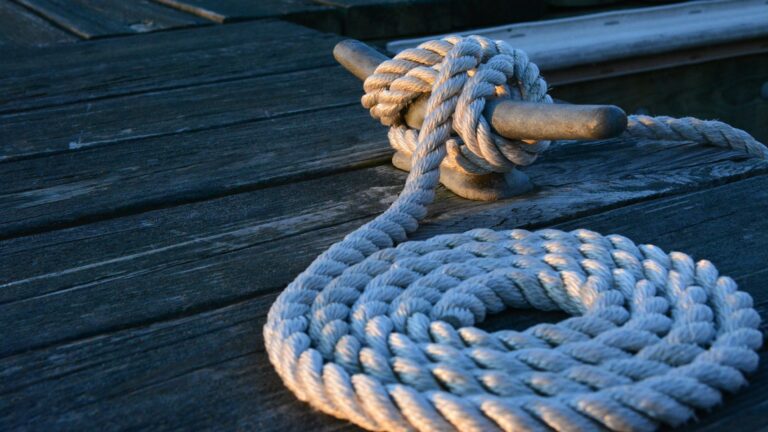Why Do They Call It a Knot?
Introduction
Knots are a fundamental part of sailing, from tying down sails to rigging boats to setting anchors and more, knots are the foundation of sailing lingo and the backbone of the nautical lifestyle. But there’s one question that often goes unanswered: why do they call it a knot?
This article will explore the history and meaning behind this nautical term and how it has impacted sailing culture throughout the centuries.
Definition of a Knot
A knot is defined as any type of loop or twist in a line or rope, used to join two pieces together or to secure an object in place. In nautical terms, knots are used to attach sails, tie down anchors, and secure ropes on boats and ships alike – but why is it called a knot? To answer this question, we must look back at its origins in maritime history.
The History of Knots
Knots have been used since ancient times – sailors have been using them for hundreds of years to connect and bind things together, as well as measure speed and distance on boats and ships. The term knot dates back to the 17th century when sailors measured their ship’s speed using a device called a ‘common log’ – a rope with knots tied at regular intervals that was attached to a piece of wood shaped like a slice of pie.
What is a Common Log?
A common log was used by sailors in the 17th century to measure their ship’s speed by counting how many knots (or loops) passed through their hands in one minute when they let out rope from the common log attached to the ship’s hull.
This gave them an accurate measure of their vessel’s speed as they could record how many knots (or nautical miles) they had traveled over time – hence why we now call speed measurements “knots”.
How was the Common Log Used?
The common log was attached to the ship’s hull with rope that had knots tied at regular intervals along its length – this allowed sailors to measure how far they had traveled based on how many knots had passed through their hands in one minute when they let out rope from the common log device.
When they needed to take an accurate measurement, they would count each knot that passed through their hands until they reached 60 seconds – after which time, they would multiply this number by 6 (the number of nautical miles per hour).
This gave them an accurate measurement of how far their vessel had traveled over time – hence why “knots” became synonymous with speed measurements in nautical terms!
Why Do We Call Speed Measurement “Knots”?
The term “knot” is derived from this practice of measuring speed using common logs, once sailors had counted all 60 seconds worth of knots passing through their hands when letting out rope from their common logs, they would multiply this number by 6 (the number of nautical miles per hour) and get an accurate measurement for their vessel’s speed – hence why we now call these measurements “knots”.
Over time, this term has become synonymous with speed measurements in nautical terms as it reflects both the accuracy and simplicity behind this age-old practice that has been used by sailors for hundreds of years!
The Meaning Behind the Nautical Term “Knot”
The term “knot” is not only derived from this practice but also reflects a deeper meaning behind its usage, when sailors used common logs to measure speed on board vessels back in the 17th century, these measurements were incredibly important as they provided information about where ships were located at any given moment – hence why tying knots was seen as symbolic for guiding ships safely across rough seas!
It also symbolizes strength, when two ropes are tied together into one knot, it can be harder than either individual rope alone! This is why ties have been so popularly used throughout sailing culture as symbols for safety, strength and guidance over hundreds of years!
Different Types Of Knots
There are many different types of knots used in sailing today, some common ones include bowline knots (used for tying anchors), figure-eight knots (used for securing sails), clove hitch knots (used for attaching rigging lines), reefing or rolling hitches (used for securing sails during windy conditions) and even sheet bend knots (used for connecting two lines together).
Each type has its own purpose depending on what you need it for! It is important to note that different types may be better suited for different tasks and conditions so make sure you know what kind you need before attempting any kind of knot tying on board your vessel!
Uses For Knots In Sailing
Knots are essential tools when sailing, whether you’re attaching rigging lines or tying down sails during windy conditions, having knowledge about different types can be incredibly useful aboard your boat or ship!
In addition to being practical tools aboard vessels though, knots also serve as symbols within sailing culture, ties have long been seen as symbols for safety, strength and guidance which makes them incredibly important within maritime traditions around the world today!
Conclusion
Knots have been essential tools within sailing culture since ancient times – not only do they serve practical purposes like attaching rigging lines or tying down sails but also represent deeper meanings associated with safety, strength and guidance over rough seas!
While there are many different types available depending on what you need them for, all originate from one source: measuring velocity using devices called “common logs” back in 17th century seafaring days which gave rise to today’s iconic term “knot”.







